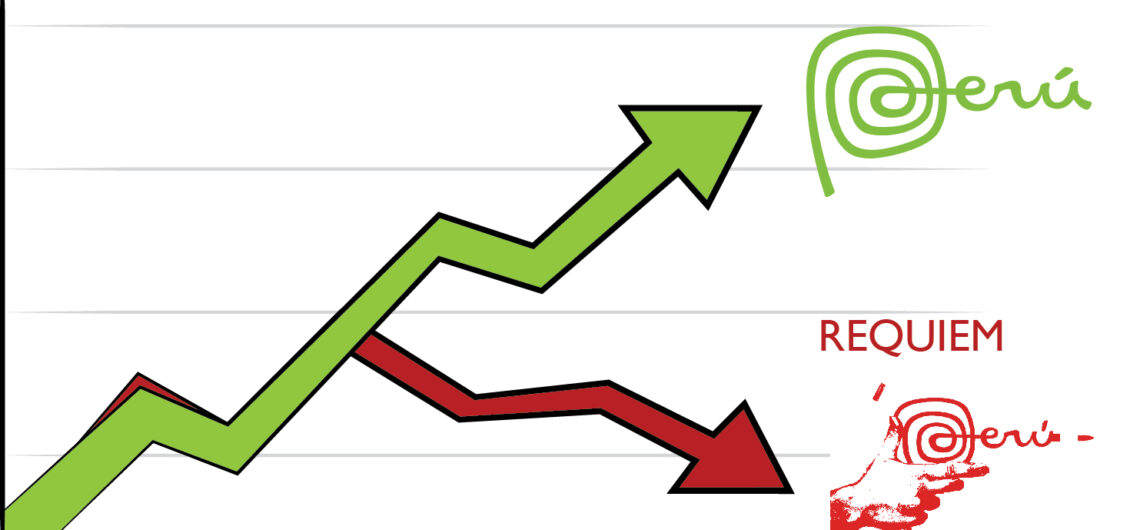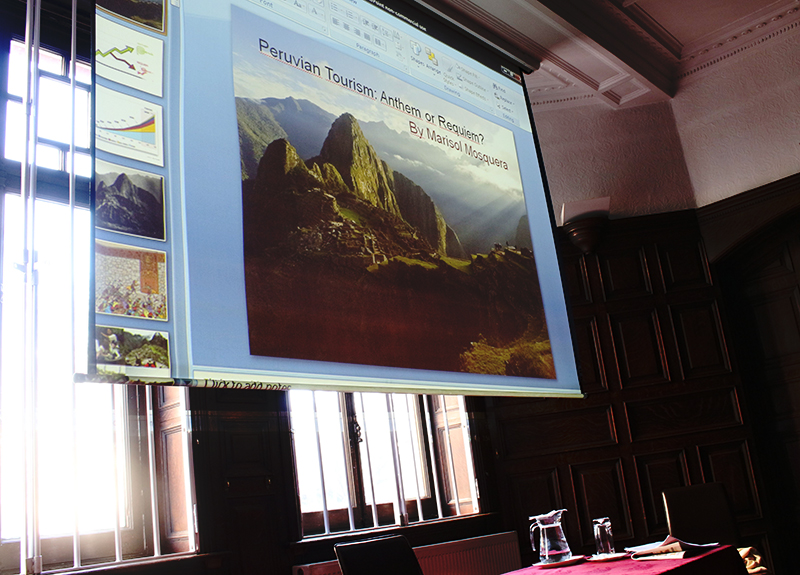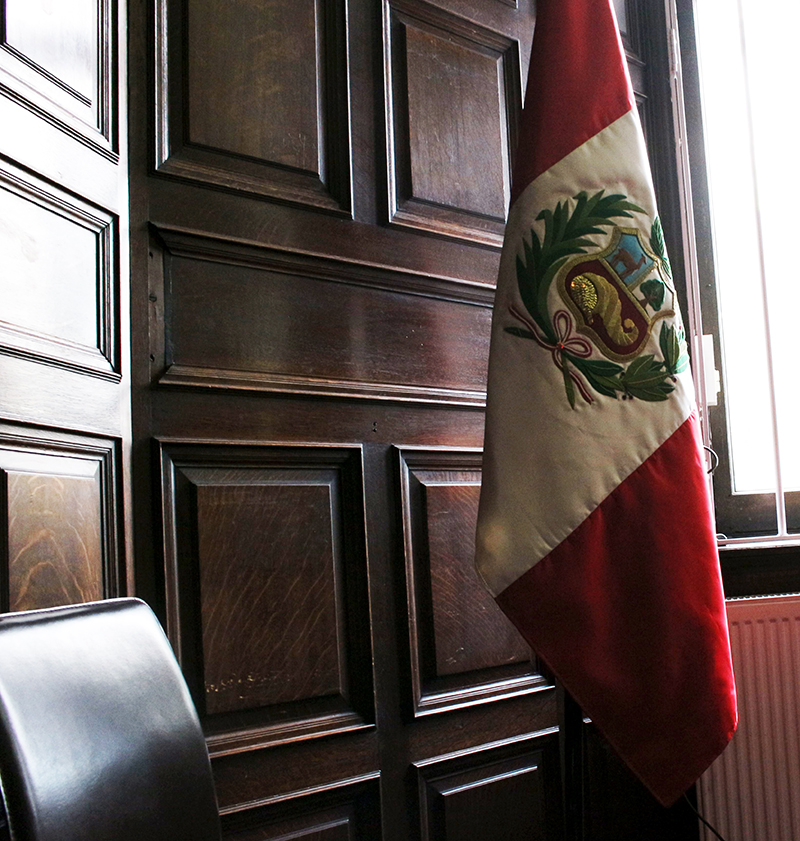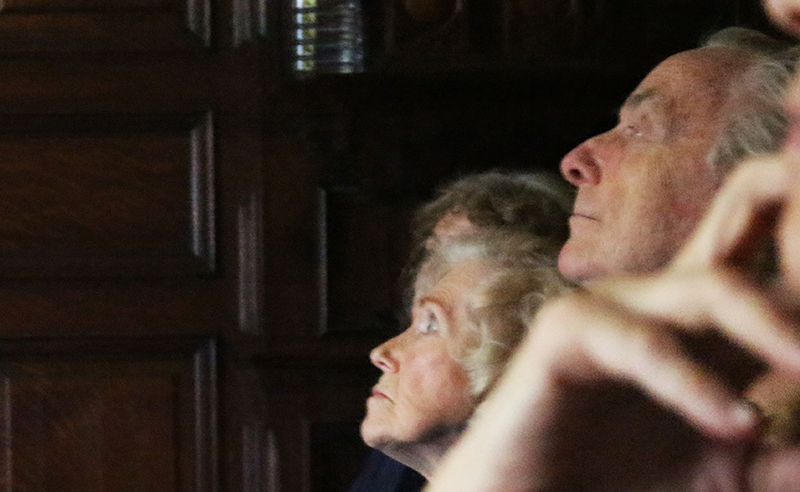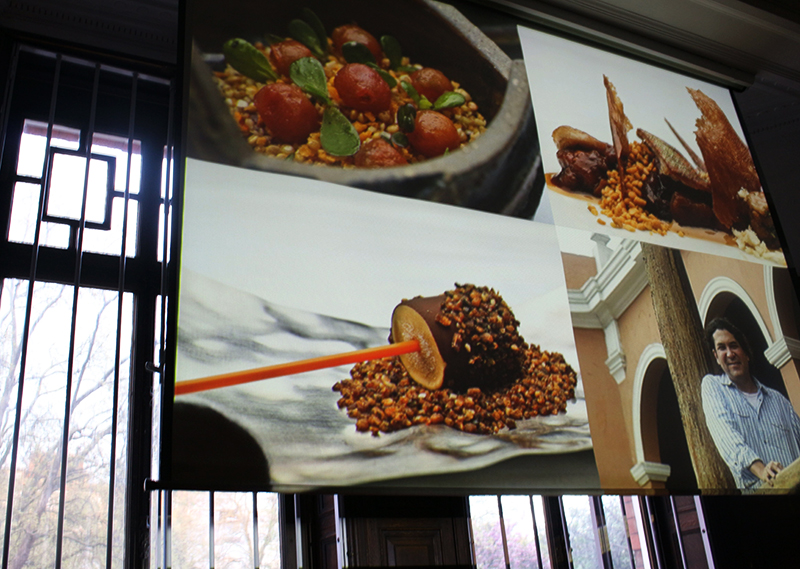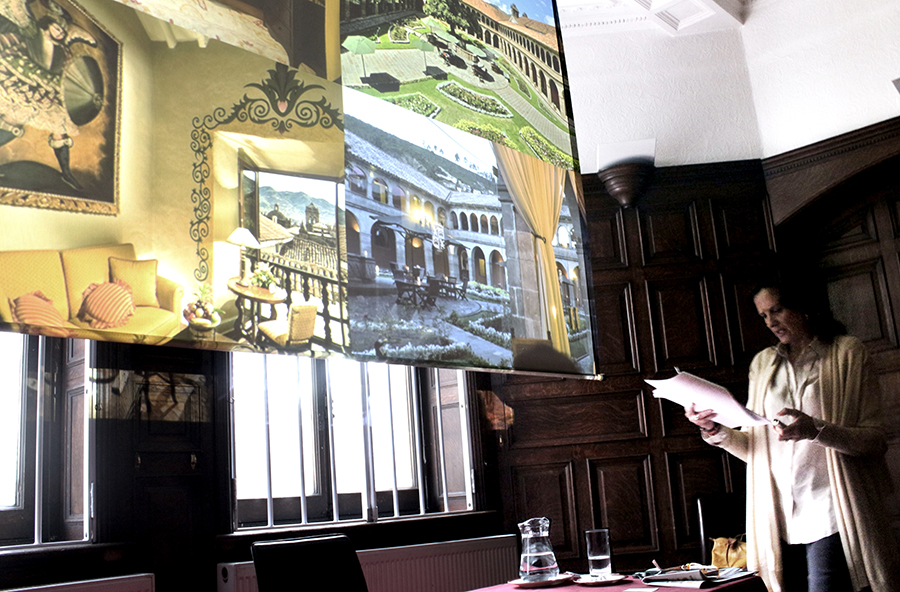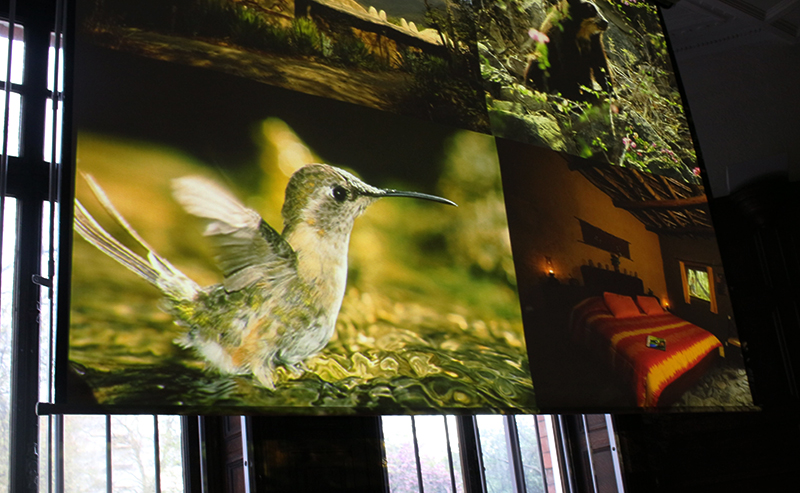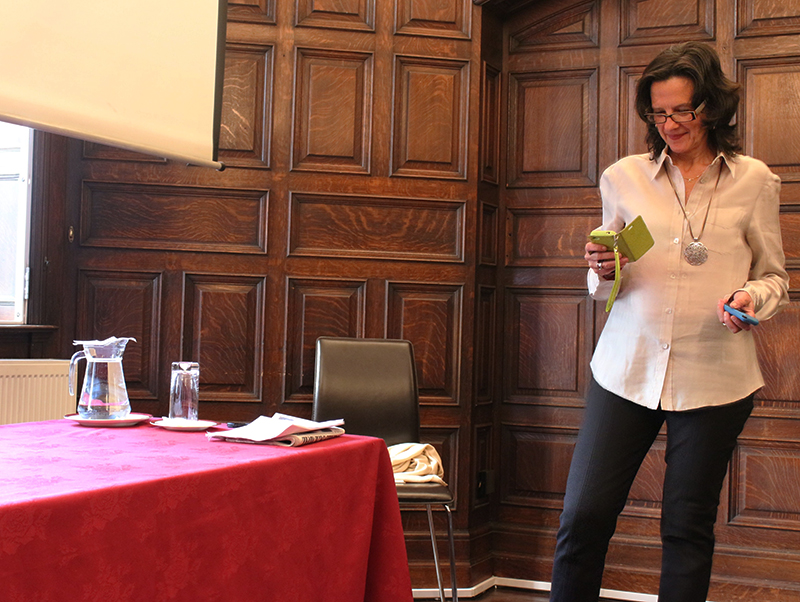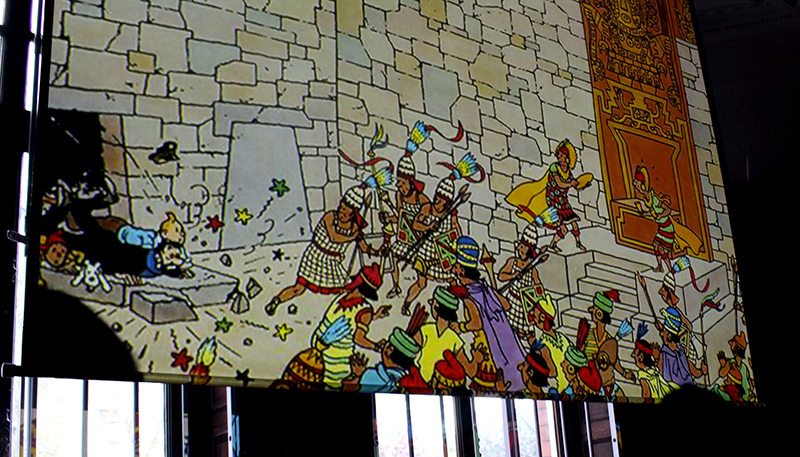Tourism in Peru over the past couple of decades has seen immense progress and growth, but with any development, the positive results are inevitably shadowed by accompanying negative effects. Looking at tourism in Peru, we could certainly sing an anthem, celebrating the many advances in infrastructure, management, quality of service and of course, the revenue that it has generated for the Peruvian economy. However, there is always room for improvement, and in Peru, some of these improvements, if not made, could be decisive, as struggles to increase sustainability, reduce environmental impact and manage major tourist destinations threaten the future of tourism in the country. Is it possible that without making changes, a decade from now we could be singing a requiem, mourning the demise of Peruvian tourism?
This is precisely the topic that Aracari founder Marisol Mosquera tackled in a talk she was invited to give by the Anglo-Peruvian Society at the Peruvian Embassy in London on Wednesday evening titled, as one might expect, “Peruvian Tourism: Anthem or Requiem?”. The Anglo-Peruvian Society, founded in 1961, aims to, “advance the education of the people of Great Britain about Peru, its people, history, language and literature, its institutions, folklore and culture and its intellectual, artistic, and economic life”. The society meets regularly and hosts events that feature a myriad of aspects of Peruvian culture and society while also fundraising for charities located in Peru. Given that Marisol has nearly two decades worth of experience in as a Peru travel specialist, she was well primed for such a discussion of the good, the bad and the ugly in the current state of tourism.
What follows is an abridged version of excerpts from Marisol’s talk, which was, by all accounts, a great success. Special acknowledgment is due to Maria Eugenia de Aliaga, Kurt Holle and Roger Valencia for their assistance in the talk.
Peruvian Tourism: Anthem or requiem?
Abridged version of the talk by Marisol Mosquera at the Peruvian Embassy in London, April 9th 2014
Peru has been experiencing a growth in arrivals of about 9% per annum which is a far greater yearly increase than most countries in the region. The main reasons behind this great success are several: compared to 15-18 years ago, Peru is now a perceived as safe country to visit, it has good hotels and infrastructure, better connectivity internationally and domestically and better press. And the marketing that PromPerú has been doing has been very effective, ranking as one of the most effective in the region, by a Competitive Analysis by the World Economic Forum.
Even if Peru ranks at the top in terms of cultural and natural attractions, it is at the bottom in the analysis considering safety and security (where Peru ranks surprisingly low, close to Mexico), hygiene and sanitation, ground transport and price competitiveness. Other factors in which Peru is also at the bottom half is environmental sustainability. And one of the pillars in the study that drags Peru down in terms of competitiveness is Peru’s inability so far to attract business travelers due, to a great degree, to the lack of conference and trade facilities. So in order to have a bright future, Peru really needs to focus now, because the resources it has are fragile and they can be gone if not looked after, and the threats are many.
Peru, particularly thanks to Machu Picchu, is in the travel bucket list of millions of people around the world. It is one of those places people want to go during their lifetime. This is a great advantage for Peru, as it provides a comparatively better starting point to attract visitors than that of other countries. Machu Picchu has mystified people for generations and triggered their imagination. This is challenge number one: to properly take care of Machu Picchu.
Protecting Machu Picchu
Peru in 2013 received 1.5 million visitors to Machu Picchu. It is of utmost importance that everybody who decides to visit Machu Picchu experiences a high degree of satisfaction, unmarred by poor facilities and poor visitor management. Today, this consistent satisfaction is generally only attained by those with a lot of money or those with a lot of time: luxury tourists or backpackers. But the public in general experiences what you see in the picture. This is negative for tourism in Peru as visitors go away with the impression that Machu Picchu is saturated, overcrowded and not worth visiting—and this is not the case.
In order to solve the issue of crowding, queues resulting from 90% of visitors arriving at Machu Picchu in the morning and staying as long as they want, lack of interpretation facilities, lack of bathrooms etc, all leading to low visitor satisfaction.
There is a proposal that is gathering strength. The idea is to enlarge the visitor area, encompassing more of the Machu Picchu Historic Sanctuary and to open up road access to create a circuit comprising the Sacred Valley, as well as sites beyond Machu Picchu such as Espiritu Pampa and Vitcos, Limatambo and Saywite.
Luxury Hotels in Peru
Lima, Cusco, the Sacred Valley and Machu Picchu are where the largest investments of upscale 4 star, 5 star and luxury properties are taking place. Properties ranging from 2 rooms to 250 rooms, with world class spas, gourmet restaurants and first class facilities have taken place.
Worth mentioning is the newest opening in Lima, Hotel B, (which made it in the cover of the New York times travel section) a Relais Chateaux property and a serious participant on the high end hotel scenario at world level. This is a Peruvian hotel and not part of an international chain.
Then there is the Country Club Hotel in San Isidro, housed in the elegant historic property also Peruvian owned and managed, and the Miraflores Park in Lima (part of the Belmond group), both deluxe 5-star properties. These are by no means the only hotels there are many others, I have just picked examples of the most sumptuous and acclaimed properties.
Major investments in 5 star properties have been made in the Sacred Valley such as Sol y Luna, Rio Sagrado and Tambo del Inka. In the City of Cusco, the Monasterio deserves a separate mention. This hotel , housed in the premises of the 16th Century Seminario de San Antonio Abad in Cusco, has been running under its current management for over a decade and it was responsible for transforming the face of Luxury Tourism in Cusco and Peru, offering deluxe accommodation in a historic setting thus far non existent in Peru. It has received many awards and worldwide acclaim. The same hotel group is responsible for Palacio Nazarenas, even more luxurious and expensive, which has yet again raised the standard.
In the Iquitos area and on a league of their own, are the fantastic cruises now cruising up the Amazon, to the reserve of Pacaya Samiria. These are among the most luxurious river cruises in the world. The smallest has four cabins and the largest sixteen.
Lake Titicaca is one of Peru´s main tourist destinations (of course well behind Cusco ). Here, there are two amazing options, each one for a different reason. Suasi island lodge is the dream of any traveler looking for ecology and sustainability in a remote location and enjoying a certain level of comfort. Titilaka is a sumptuous beautifully interior decorated property with excellent service in a remote, beautiful location.
The northern coast (Mancora) known for its beaches and surfing, and southern coast (Paracas area), where one goes to see the Nazca Lines, there are also wonderful options now.
And in Huaraz and Callejon de Huaylas, an area of stunning natural beauty and also major cultural attractions, now there are charming upscale accommodation options that were unheard of: Llanganuco Lodge, Lazy Dog Inn and the latest, Cuesta Serena.
Infrastructure
I think all those of you who have recently been Peru will agree with me that Lima airport has come a long way. The infrastructure and facilities at Lima Airport as well as connectivity thanks to better airlines and more flight frequencies has helped tourism greatly.
There is work under way at Pisco Airport, and of course the much discussed and controversial Chinchero airport project near Cusco. On what there seems to be a consensus, is that of all the areas contemplated for a new and very necessary airport in the Cusco area, Chinchero is the best option.
The trains have experienced a major overhaul and the vision of Perurail to establish a luxury service has actually done a lot to raise the standard ** regionally** (ie South America) for luxury train travel.
On roads there have been marked improvements to certain routes such as Pisco to Ayacucho, Nasca- Abancay- Cusco and certainly the Cusco to Puerto Maldonado route. But again Peru ranks very low in road transportation safety, which is a big problem for tourism.
Museums and Cultural Centers
Another area where much improvement has taken place is in the wide array of Museums and cultural venues that have emerged, not only in Lima but also in provincial towns.
The Museo de Arte de Lima has experienced a wonderful revival and the long awaited Museo de Arte Contemporáneo is now in a gleaming new locale in Barranco along with MATE, Mario Testino´s cultural center, which has catapulted Lima as a magnet for style seekers. The Museo Larco has been dramatically renovated and now opens 365 days a year until 10pm to enable visitors with late air departures to visit the museum before going to the airport. One of my personal favoruites is the “Museo de Gastronomia” located in the Historic Centre of Lima, showing in a very educational way the history of Peruvian gastronomy, its regional produce and influences.
La Ruta Moche, which is essentially a string of wonderful pre-Inca sites and Museums located in the vicinity of Trujillo and Chiclayo, is one of the exciting initiatives of tourism in the last 18 years. These sites include El Brujo, Huaca de La Luna, Chan Chan, Tucume and Sipan. The Tumbas Reales Museum and the lovely Gerardo Chavez contemporary art museum in Trujillo. Technically outside the Ruta Moche but worth mentioning is the ancient archaeological site of Caral, where major headway has been made in the development of the archaeological site into a tourism product and is successfully attracting visitors now. And the Centro Mallqui in Leymebamba a 100% privately funded museum housing the treasures of the Chachapoyas culture.
Peruvian Cuisine
As you all know, I the last 10 years, Peruvian cuisine has been catapulted to the world stage. Popularity has grown to such a degree that restaurants & Peruvian food are migrating to other countries ( La Mar is in New York, Bogota, Miami, San Francisco & Sao Paulo; Astrid & Gaston in Madrid etc, and Lima Restaurant in London has one Michelin star).
3 Peruvian Restaurants are listed in the World’s Top 100
Central made the San Pellegrino Top 50 list April 2013; Astrid and Gaston on the list for 3 years running since 2011.
With this immensely rich endowment, tourism professionals are creating innovative and interesting products to satisfy the growing demand of international guests.
Examples of Sustainability
The nature of tourism in Peru, as mentioned in the beginning of this talk, has a big bias on cultural tourism. As such, and with the prevalence of varied and very traditional ethnic communities throughout Peru, community based tourism is a big attraction.
Heritage Tourism, to visit architectural and archaeological sites is also of prime importance. Peru has a myriad of archaeological sites around the country, and more and more are discovered every day. They need to be made into tourism products, by means of managing them properly via the concerted effort of the public and private sectors.
By the same token, ecotourism is also immensely important in a country where protected areas conform a very large part of the total territory.
Peru has made headway in all three types of tourism. Of course the journey to achieve sustainability in tourism is fraught with difficulty and there are many challenges ahead. But there are also success stories to be told:
- Andean Lodges, is a chain of lodges in the Ausangate area of southern Cusco, that beautifully brings in the local communities into the tourism equation.
- The Centro de Textiles Tradicionales de Cusco, a non profit that fosters traditional weaving techniques. The international market of upscale visitors has provided the market they need for their high quality pieces.
- Tierra de los Yachaqs, and NGO trained series of communities in the highlands over Pisac that are organized to run visits to show foreigners their lifestyle and Andean cosmovision.
- In Lake Titicaca, there are some excellent examples of sustainable tourism. Some initiatives are more isolated and pristine, and other especially in Uros could be considered overrun by tourism and providing a low quality visitor experience but the essence is that they all are bringing wealth to the local communities.
- Huaca Pucllana is a great example of a site, that only 30 years ago was a vacant area and now thanks to a successful model between the Municipality, the State and the Private sector is a successful and well preserved heritage site.
- Likewise, both Huaca de la Luna and El Brujo are successful examples of private funding turning valuable archaeological resources into successful and properly managed tourism attractions.
- In EcoTourism, a wonderful and little know example is Chaparri, where Heinz Plenge, the Peruvian photographer has initiated this project a few years ago which is a reality now. This is now a 36,000 hectare area on the hills over Chiclayo in conjunction with the local community of Santa Rosa de Chongoyape into a private ecological reserve :
- In Tambopata, Rainforest Expeditions has done a great job at sharing actual management of the projects with the local communities, or educating the local communities to self run their initiatives.
Conclusions
Innovation, commitment, creativity, perseverance and consensus between the private and public sectors are key to ensure we turn Peru into the success story it deserves to be. And I leave you with a picture of Machu Picchu from the other side than you usually see it from, so you are reassured that there is always different ways to see the places we already know, everywhere, but especially in Peru.

